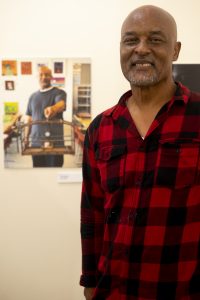Tamica Jean-Charles/Assistant Entertainment Director
Gary Allen is seen softly smiling, holding a cage with a single egg within. The egg is facing a door-less entry-way. The egg, once hatched, has every opportunity to leave, yet remains hesitant within the copper bounds of the cage.
In 2014, Allen found himself living under a bridge. He needed to find the purpose to get him out of his own cage.
“I knew help was coming, I didn’t know how exactly it would come,” said Allen. “It was like I was being pushed into my purpose because I didn’t want anything less than my purpose and to live my potential in life.”
Later that year, Allen found himself working in the art therapy room at Camillus House, a full-service homeless shelter near Downtown Miami. He calls the room the heart room; it’s a place where people can be free, and live a life of purpose through their art.

Cathedral Beauford has been homeless for over 41 years. Her granddaughter took the picture she’s standing next to. It shows Beauford in the passenger seat of a car. There’s a man lying down on the sidewalk under an overpass. Cathedral’s face is blank, but her eyes prompt a different thought. Gerard Albert III/PantherNOW.
“People have so much inside of them, and I think that’s one of the main reasons why people get isolated and drift off,” said Allen. “They’re tired of keeping up with the machine.”
Allen’s, along with other Camillus House clients, photos are featured in the Neighborhoods of Refuge, a traveling photo exhibit depicting the lives of homeless individuals in Miami.
The idea came to Matthew Marr, associate professor of sociology at FIU, back in January after he was granted a $10,000 grant through The Humanities Edge, a social science and history-centered program for Miami Dade College humanities students transferring to FIU.
Marr saw Allen and Camillus House as a great opportunity for the grant. Marr, along with MDC professor, Alejandro Angee, gathered eight undergrad and graduate students to work on this project.

Gary Allen has been working with Camillus House in 2014, the same year he found himself living under a bridge in Miami.
“I thought it was an interesting way to get people of Camillus House involved, and to be able to tell their stories unprompted by questions, just with cameras and photo captions,” said Marr.
FIU grad student, Natalia Marques da Silva proposed using photovoice, a method of photography used to document and reflect the reality of certain groups of people, to Marr. She suggested the project participants use small, digital cameras to capture their versions of reality.
“We needed the cameras to be small so that it was easy for people to carry around, and also easy for people who did not have experience with photography,” said Marques da Silva.
Marr was skeptical over the use of digital cameras at first, he said. He originally thought the end result would be the same and less costly if the participants were to post their pictures on a photo-focused, online platform like Instagram.
Yet, Neighborhoods of Refuge taught Marr to be patient. He said the project was a bit unstructured and many of the photographers struggled to open up at first. Still, through the eye-opening discussions arising from the photo captions, Marr came around.
“Having the discussions face to face enhanced the meaning behind the pictures,” said Marr. “The captions were enough to get people thinking.”
The consistency of the photogs and coordinators posed as a challenge for the project. Some of the student researchers had other obligations, limiting their input with the project. Many of the homeless participants, Marr said, had issues with housing and would disappear for moments at a time.
One participant, in fact, was in and out of cancer treatment and shortly passed away before the project concluded.
“In a subtle way, it brought awareness to the [homeslessness] issue,” said Marr. “We’re not trying to push something specific with a bias. We’re just showing people the [homeless] experience and letting them think on their own.”
The researchers collected the photos and captions and set up the exhibit in the art therapy room at Camillus House in May.
Marques da Silva hopped on the project while Marr was writing the grant. She had worked on a similar project during her undergrad at the University of Central Florida, yet she said there was something about Neighborhoods of Refuge that she couldn’t ignore.
Marques da Silva focused more on the technical side of the project–cameras, photos, website and exhibit. At some point she found herself overwhelmed with the technicalities. Marques da Silva says she underestimated the community aspect of the project.
“It was really intense. There were moments I got caught up in the photography,” said Marques da Silva.
While interacting with those involved with the project, Marques da Silva fell in love with the community the people built among themselves.
“People have this perception of constant worry, but they’re just trying to build a community,” said Marques da Silva.

Jacqueline Hernandez moved down to Florida in 2001 after her mother suffered a stroke. Six years later, Hernandez found herself without her pension, without a home, and without her mom. Her time in Florida, she says, taught her the art of the “hustle.” “I was able to start over, to continue struggling and fighting,” said Hernandez. Gerard Albert III/PantherNOW.
“You don’t see the things they see until you see the photos and captions,” said Marques da Silva. “Yet, it’s that one on one time that you realize things that you didn’t know before.”
The exhibit will be at the School of International and Public Affairs gallery for the next two months before moving to Miami-Dade College. For more information, visit humanitiesedge.fiu.edu
“This project doesn’t care whether you’re uncomfortable or not,” said De Silva. “It forces you to confront it, and look at the person in the eye.”
Oct. 2, 1978–41 years. That’s how long Cathedral Beauford has been homeless in Miami. She touches one of her photos hanging on the wall.
Her granddaughter took the picture. It shows Beauford in the passenger seat of a car. There’s a man lying down on the sidewalk under an overpass. Cathedral’s face is blank, but her eyes prompt a different thought.
She says through the past 41 years in a world of refuge, she remains optimistic, with a desire to change the world around her.
“I think about hope and love and peace,” said Beauford looking at her photograph.”





Be the first to comment on "Neighborhoods of Refuge depicts the reality of Miami’s homeless"